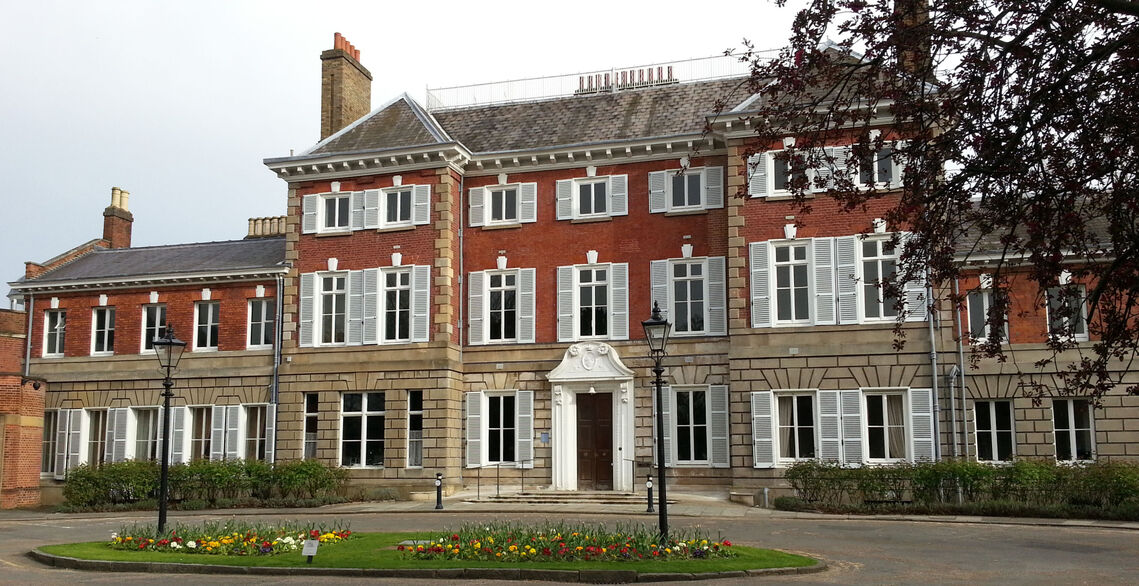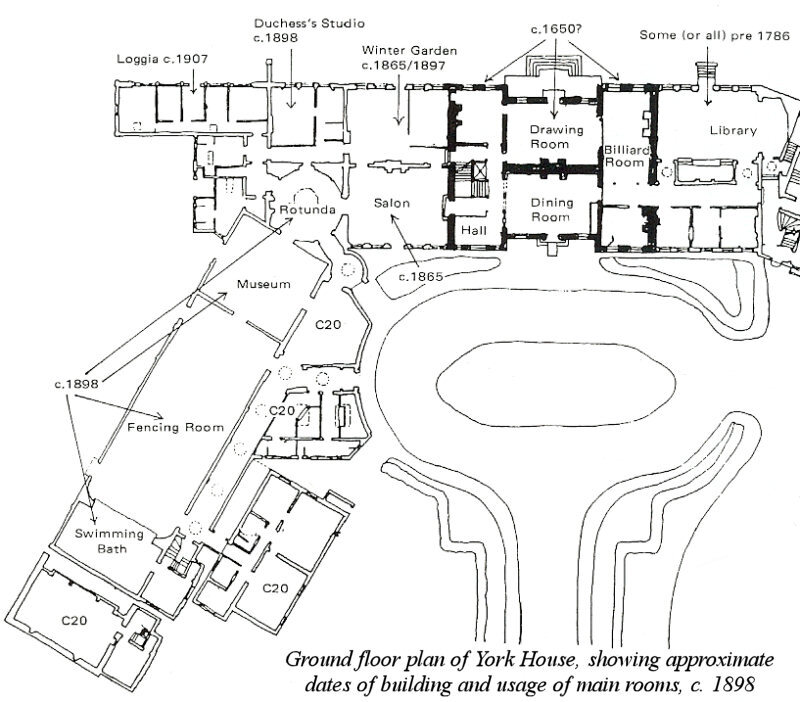L'histoire en français est ici
York House has been a town hall since 1926—first for Twickenham and then after 1965 for the London Borough of Richmond-upon-Thames. The latter is an amalgamation of three former boroughs, Barnes, Richmond, and Twickenham. Their plate and regalia are on display in the entrance hall, including three silver gilt maces.
The building was saved for posterity after a campaign led by the York House Society. That group, formed in 1922, dissuaded the local council from putting up a new town hall near the old one in King Street, and prevented the site being cleared for housing development. The campaign was to support Twickenham’s petition for a borough charter. It claimed a connection between the house and the Duke of York who became King James II (1633—1701), and this claim led to an opening ceremony on 16 November 1926, a day to celebrate the grant of a charter, by the Duke of York who became King George VI (1895—1952). It was believed that Queen Mary II and Queen Anne as children of James II had regularly visited York House during the time (1661-1674) it was owned by the Earl of Clarendon (1609—1674), King James’s father-in-law. There is no evidence of such visits, and Lord Clarendon lived in exile in France from 1667 onwards.
York House: the origins
In fact the name of the house is not derived from royalty but from the York family which held this area of land from the 14th to the 17th century, called York Manor or Yorkhold. The core of the building is the original mansion of the 1630s (marked in black on the ground floor plan), which was then entered by a door in the north-eastern corner.
The present central main entrance added in 1897-8 now brings the visitor into what had been the dining room to face its fireplace and over mantle. Behind that wall was the sitting room, now called the terrace room. The other obvious evidence of the early 17th century is the main staircase, somewhat obscured by the lift inserted by the borough council into the stairwell. The banisters are evidence of the house’s origin. Its builder and first owner was Andrew Pitcarne (d.1640), who had been a page and then a groom of the bedchamber to King Charles I (1600—1649).
The French Royal Family, and Sir Ratan Tata
The present layout of the building and grounds (see the floor plan above) owes much to the changes which took place during the last twenty-five years when it was in private hands—those of the Duke of Orleans (1869—1926) of the exiled French royal family who purchased the house for £13,000 in 1897 and of Sir Ratan Tata (1871—1918), the Indian industrialist and businessman, who bid £16,000 at an auction in 1906. Lady Tata sold the property to Twickenham Urban District Council in 1924 for £20,500. The Duke, a grandson of Louis Philippe, King of the French from 1830 to 1848, had possession for nine years (1897—1906). He added what are now the Clarendon Hall and its associated buildings as extensions to the north-east corner of the house, so that he could have a fencing hall, a swimming bath and a museum.
The French fleur-de-lys which is much in evidence on the down spouts, the interior plaster work, and even on the wire balloons of the vent pipes, testify to the fact that the Duke had purchased the home of his childhood. His father, the Count of Paris (1838—1894), had resided in York House for seven years (1864-71). The Duke had been born there in 1869. His father had extended the eastern side of the house by adding the salon and the Winter Garden. The salon now used for many ceremonies is a room added in the late 1860s with decorations in the rococo style. After standing empty for several years the house was acquired in 1876 by Sir Mountstuart Grant Duff who sold it to the Duke in 1897.

Sir Ratan and Lady Tata who occupied the premises for twelve years (1906—1918) converted the Duke’s fencing hall and museum into picture galleries so that they could hang their collection of paintings, now in the proud ownership of the Mumbai Art Gallery. Lady Tata as a widow was in residence for another four years. The Duke and Sir Ratan also transformed the garden and grounds. The Duke enclosed the meadow by the river; Sir Ratan excavated the main lawn to create the present sunken garden, replaced a bridge over the road with the present stone one, and in 1909 acquired the fountain and statues which decorate the meadow garden. The sculptures, known locally as ‘the naked ladies’, are of Carrara marble and represent the Oceanides or sea nymphs of Greek mythology.
Before the arrival of the French royal family in the 1860s the main alterations to this 17th century building were the addition of a false hip roof and of a western extension, both in the 18th century. The site of the western extension has been modified in order to house the present council debating chamber. All the windows have also been renovated to give the whole building an 18th century appearance. The second floor seems to have been part of the owners’ accommodation. The absence of an attic with servants’ rooms suggests that there used to be other houses for them.
York House and Twickenham
The part played by the house in the history of Twickenham was at its most obvious in the late 19th and early 20th centuries. Before that, between the 1720s and the 1860s, it was frequently left empty by its owners or let to tenants for short term occupation. The Austrian ambassador, Count Stahremberg, was in residence from 1796 to 1807. Mrs Anne Seymour Damer, a sculptress and a blue stocking who had lived in Strawberry Hill, used the house as her summer residence between 1818 and 1828. Other tenants were the Dowager Duchess of Roxboroughe until 1837 and the Earl of Lonsdale until 1844. But the impact of the arrival of the exiled French royal family on Twickenham tradesmen and servants was through Highshot House in Crown Road where Louis Philippe, a direct descendant of the brother of King Louis XIV, had lived in exile from 1800 to 1807, and then through Orleans House where he lived from 1815 to 1817. The latter building was acquired on behalf of his son, the Duke of Aumale (1822—1897) in 1852. The Duke’s nephew, the Count of Paris, bought York House only after other members of his family had already moved into the district. Frances, Lady Waldegrave (1821—1879), of Strawberry Hill was the principal local hostess to assist in launching the French princes into London high society.
York House was used for this kind of entertainment largely before and after the residence of the Duke of Orleans. Although he made many alterations to the building, he made little use of its facilities after the first three years of his ownership. He became unpopular for the support he gave to the Boers during the South African war, and after 1900 he preferred to use the estate at Wood Norton near Evesham which he had inherited from his great uncle. York House was known for its hospitality during the years it was in the hands of the Duke’s predecessor, Sir Mountstuart Grant Duff (1829—1906) and of his successor, Sir Ratan Tata. Grant Duff, apart from his period of office as Governor of Madras from 1881 to 1885, had regular weekend parties In York House between 1876 and 1896. A Liberal Party MP and a junior minister in Gladstone’s first government, he was prominent in public life. When he left Twickenham, there was a proposal by the London School Board that the house might be converted into a home for persistent truants. The Duke’s purchase was regarded as a blessing by local people. Sir Ratan Tata, a philanthropist who gave money to promote public health and reduce poverty, enjoyed holding large garden parties in York House grounds. One held in July 1914 just before the outbreak of war had 1,500 guests.
More recently
Since 1926 the building has principally been used for municipal committee meetings or ceremonials. It was never deemed large enough to house all the officers and staff serving the borough which has always had to provide further accommodation. The Civic Centre erected in 1987-91 on the York Street side of York House constitutes the main purpose-built office block; others are scattered throughout the borough.
This introduction was prepared by Professor J.M. Lee with help from members of the York House Society, and from Dr.T.H.R. Cashmore and Anthony Beckles Willson who published a monograph in 1990 for the Borough of Twickenham, Local History Society ISBN 0 903341 51 4. The Twickenham Museum website gives more information.

